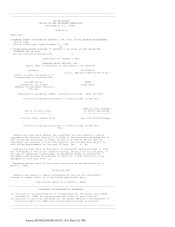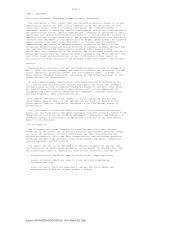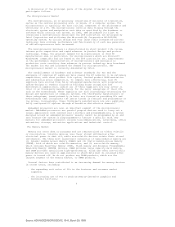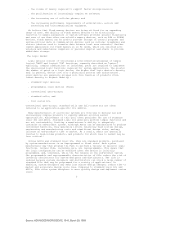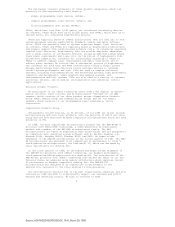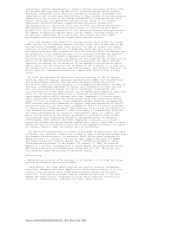AMD 1998 Annual Report Download - page 13
Download and view the complete annual report
Please find page 13 of the 1998 AMD annual report below. You can navigate through the pages in the report by either clicking on the pages listed below, or by using the keyword search tool below to find specific information within the annual report. Manufacturing technology is the key determinant in the improvement in
semiconductor products. Each new generation of process technology has resulted
in products with higher speeds and greater performance produced at lower cost.
We continue to make significant infrastructure investments to enable us to
continue to achieve high volume, high reliability and low cost production
using leading edge process technology.
Our efforts concerning process technologies are focused in three major
areas: logic technology used by our microprocessors and embedded processors;
non-volatile memory technology used by Flash memory products; and programmable
logic technology used in the Vantis programmable logic products. Our goals are
to increase density and improve product performance, to increase the clock
speed for microprocessor products and to reduce the access time for non-
volatile memory products.
In order to remain competitive, we must make continuing substantial
investments in improving our process technologies. In particular, we have made
and continue to make significant research and development investments in the
technologies and equipment used in the fabrication of our microprocessor
products and in the fabrication of Flash memory devices. If we are not
successful in our microprocessor and Flash memory businesses, we will be
unable to recover such investments, which could have a material adverse effect
on our business. In addition, if we are unable to remain competitive with
respect to process technology we could be materially and adversely affected.
Competition
The IC industry is intensely competitive and, historically, has experienced
rapid technological advances in product and system technologies. After a
product is introduced, prices normally decrease over time as production
efficiency and competition increase, and as successive generations of products
are developed and introduced for sale. Technological advances in the industry
result in frequent product introductions, regular price reductions, short
product life cycles and increased product capabilities that may result in
significant performance improvements. Competition in the sale of ICs is based
on:
. performance;
. product quality and reliability;
. price;
. adherence to industry standards;
. software and hardware compatibility;
. marketing and distribution capability;
. brand recognition;
. financial strength; and
. ability to deliver in large volumes on a timely basis.
In each particular market in which we participate, we face competition from
different groups of companies. With respect to microprocessors, Intel holds a
dominant market position. With respect to the Memory Group, our principal
competitors are Intel, Sharp and Atmel. We compete to a lesser degree with
Fujitsu, our joint venture partner in FASL. With respect to the Communications
Group product lines, our principal competitors are SGS-Thomson
Microelectronics N.V., Texas Instruments Incorporated, Siemens Corporation,
NEC Corporation, LM Ericsson, Alcatel Alsthom, National Semiconductor, 3Com
Corporation, Intel Corporation and Motorola, Inc. In Vantis' market, our
principal competitors are Altera Corporation, Lattice Semiconductor
Corporation, Xilinx, Inc. and other smaller companies focused on PLD
development and production.
Manufacturing Facilities
Our current IC manufacturing facilities are described in the chart set forth
below:
10
Source: ADVANCED MICRO DEVIC, 10-K, March 29, 1999



